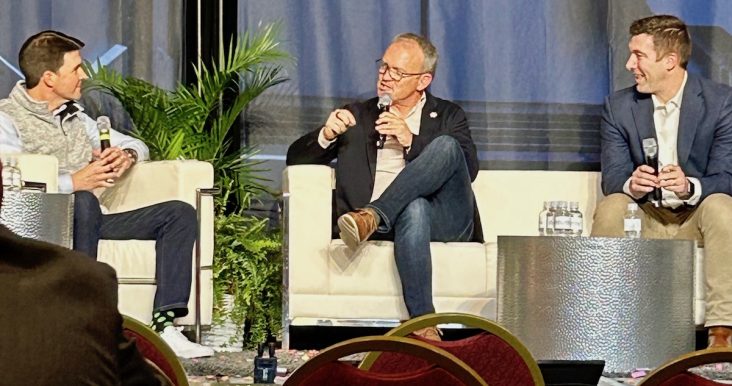Walmart merchant, product execs work to stay current on customer demands
by November 6, 2023 5:27 pm 1,382 views

(from left) Kevin Meagher, a principal at Deloitte, held a fireside chat on customer-centric strategies with Jon Alferness, chief product officer at Walmart, and Brock McKeel, divisional merchandise manager of electronics at Walmart U.S., during the NWA Technology Summit in Rogers on Oct. 31.
Sam Walton’s mantra of the customer being No. 1 is still the focus for Brock McKeel, divisional merchandise manager for consumer electronics at Walmart U.S., and Jon Alferness, chief product officer.
McKeel and Alferness recently took part in a fireside chat with Kevin Meagher of Deloitte at the NWA Technology Summit in Rogers where they discussed efforts to transform the shopping experience in a highly competitive retail environment.
McKeel said customers are busier than ever and at least in the technology space, rely heavily on the phones in their pockets to get what they need, whether that’s information, groceries or checking in with the family via text. He said the electronics business is ever-changing and it’s his job to ensure Walmart has the right assortment, at the best price at the right time. That includes everything from phone chargers to speakers to home security systems not to mention electronic screens from the iWatch to the 85-inch flat-screen television.
McKeel said Walmart stores are representative of the communities where they are located. He said not every zip code has the same needs or economic wherewithal and stores should reflect entry-price points as well as higher-priced items so that all customers have access to the technology they need.
“Our mission to save people money so they can live better is core to what we do. But we don’t talk that much about the live better part. In electronics we have an opportunity to transform customer’s experiences through affordable smartphones or streaming devices,” he said.
Alferness said employees in his department design the digital products used by customers and employees and their focus is to improve the overall experiences in stores and online.
“Customer journey in omnichannel retail cuts through several business segments at Walmart, but to the customer it’s one singular journey — end to end. My team works to make sure customers don’t feel friction or frustration but enjoy an easy experience time and time again,” he said.
He said product development employees include engineers and designers on the technology end and business teams to make sure the products developed solve the right problems.
One product known as MIAD was developed for store employees using generative AI. Alferness said Walmart fed its rich proprietary data in the large language model to be a data source for store employees that serve as search assistants. He said customers benefit from MIAD too as when a shopper in the toy department asks an employee for ideas about a 7-year-old girl’s birthday gift, the employee can ask the assistant and give an informed suggestion. Alferness said MIAD was trained with Walmart’s data and also brings in outside sources of information to give an informed answer.
McKeel said MIAD has been great in the electronics department as the questions employees get are often technical and complex. Before MIAD, store departments kept manual books that employees could refer to for data, but they were not as comprehensive and up-to-date as the new digital sources.
Omnichannel merchants must know much more than category brand, market share data and price, McKeel said.. There is social media to watch that is also an indicator of demand, emerging trends and customer preferences. He said there are many ways a small brand can disrupt a category through social media that would have never been the case 10 years ago.
McKeel, who worked in grocery before electronics, said there have been instances where a small brand owned a category because the legacy brands would not adapt. He said Walmart has been able to step in and be the disruptor in some cases with private brands because legacy brands would not adapt.
“You can be the change, you can signal a change or react to the change, but unless you listen to your customers you will likely miss the change. The change might simply be a more sustainable product. Customers respond with their wallets when you listen to and deliver on their needs,” he said.
